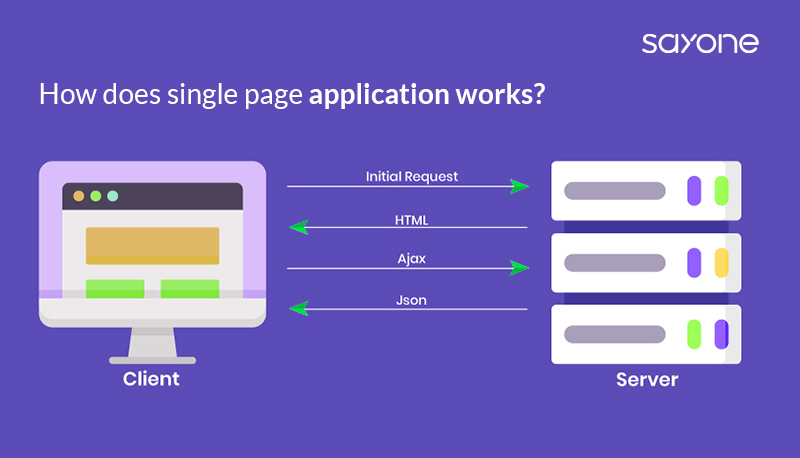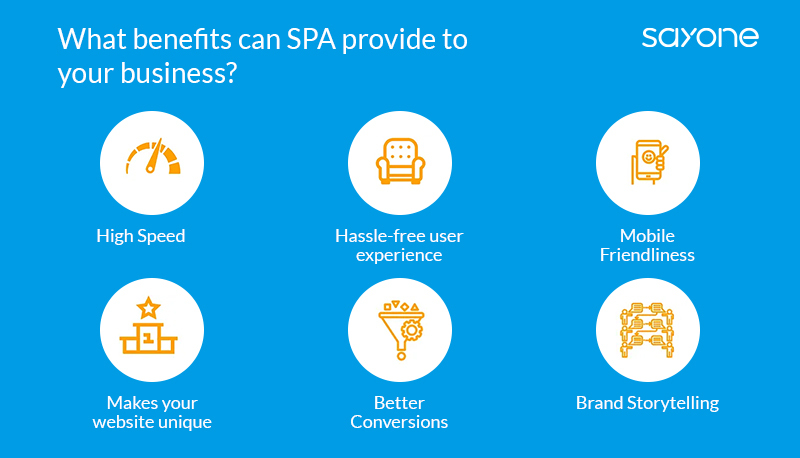Benefits of Single Page Applications (SPAs) in Web Development

Share This Article
Why is Responsive Web Design Important?
Table of Contents
Subscribe to Our Blog
We're committed to your privacy. SayOne uses the information you provide to us to contact you about our relevant content, products, and services. check out our privacy policy.
What Are Single Page Applications?
In the simplest terms, a Single Page Application (SPA) is a web application that operates within a single web page. Unlike traditional websites, which reload most resources with each user action, SPAs reload only necessary content. This model hinges on JavaScript, HTML5, and CSS3 to update information on the current page dynamically without the server having to render a new one each time.
The Rising Popularity of SPAs
Why are developers and businesses turning to SPAs? The key is their slick user interactions. Users appreciate the lack of page refresh interruption, which mirrors the smoothness of desktop applications. It's this fast and fluid experience that's making SPAs a go-to choice, especially for applications demanding real-time data updates, such as social media feeds, email platforms, and maps.
How Do SPAs Work?

SPAs hinge on AJAX – a web development technique for creating interactive web applications – to load content behind the scenes. They fetch data independently of the UI (User Interface), so users can continue using the application while new information is being retrieved and displayed without full-page reloads. It's a bit like replacing a worn-out part of a machine without having to shut the whole thing down quick and specific to the task at hand.
SPAs are reshaping the user's web journey into a faster, more interactive experience. With the ability to update content without a full refresh, they offer a fluid, app-like experience straight from the web browser.
Core Features of Single Page Applications (SPAs)
Journey from Click to Display
When you interact with an SPA, the magic begins with a single page load. Unlike traditional websites, there's no constant back and forth with the server. Instead, all the necessary HTML, JavaScript, and CSS get loaded up once. As you navigate, only data shuffles in and out, not entire pages. This means your experience is snappier and more fluid.
Checkout The Complete guide on Java Microservices Architecture
AJAX: The Data Handshake
SPAs rely heavily on AJAX (Asynchronous JavaScript and XML). This technology lets the app request small chunks of data from the server without reloading the whole page. It's like having a conversation with a friend without having to hang up and redial for each sentence. This approach keeps things quick and reduces load times.
Explore the 10 Different Types of Web Applications & Their Uses
Instant Feedback Loop
Real-time interaction is a standout feature of SPAs. As you click, type, or swipe, the application reacts immediately. There's no waiting for a page refresh; it's all about keeping you in the flow. This immediate response keeps users engaged, making tasks from shopping to data entry feel more like a natural conversation than a clunky process.
This trio of characteristics - a singular load, data on demand via AJAX, and swift response times - marks the essence of SPAs. They're designed to get you where you need to go faster, without the page reload shuffle, keeping you in the groove with instant feedback.
Improved User Experience with SPAs
Single Page Applications (SPAs) are transforming the way users engage with web platforms. By updating content dynamically, SPAs like Gmail keep users on the page, increasing interaction without the need for a full page refresh when sifting through emails. This approach reduces wait times and potential frustration, making the user's task of managing emails much more straightforward.
Streamlined Navigation and Content Presentation
SPAs enable content to be presented without traditional page reloads, providing a smooth and consistent experience.
Navigation within these applications feels swift, mirroring the speed of native apps.
Real-World Success Stories
- Gmail: The convenience of managing emails without page reloads has become a standard expectation for modern webmail services, thanks to Gmail's SPA approach.
- Netflix: Leveraging the React framework, Netflix delivers an uninterrupted streaming experience that allows users to browse and watch videos without the jarring experience of page reloads.
- Grammarly: Utilizing Vue.js, Grammarly offers real-time, AI-driven writing assistance within the same webpage, enhancing the writing process without navigating away from the text being edited.
- Trello: Known for its project management capabilities, Trello employs Backbone.js to facilitate task management and assignment through a responsive, update-without-reload user interface.
Checkout 5 Microservices Examples: Amazon, Netflix, Uber, Spotify & Etsy
These tech leaders have demonstrated that adopting SPA architecture can result in a highly responsive and user-friendly interface, leading to increased user satisfaction and retention.
Performance Advantages of SPAs

Quick Loading Times
Single Page Applications shine when it comes to speed. They minimize server requests by loading all the necessary HTML, CSS, and scripts upon the initial request. This means any subsequent interactions don't trigger the traditional page reload, resulting in a zippier user experience.
Smart Resource Handling
SPAs are a game-changer in how they manage resources. By only updating the necessary content instead of reloading entire pages, they cut down on bandwidth use. This efficient approach not only speeds things up but also conserves data – a win for both user and developer.
SPAs vs. Multi-Page Applications
In a head-to-head with traditional multi-page setups, SPAs often come out on top. While multi-page apps send requests to the server for each page load, which can slow things down, SPAs handle this client-side. That means less wait time for users and a smoother interaction with the site.
Scalability and Maintenance of SPAs
Updating and maintaining a single codebase:
Single Page Applications come with the convenience of a singular codebase, making updates a straightforward process. When changes are needed, developers can dive into one set of files, ensuring consistency and reducing the chance of errors that often accompany multiple codebases.
Strategies for scaling SPAs for high traffic:
Handling a surge in users is all about planning. For SPAs, this often means focusing on the server's ability to handle API calls efficiently. Utilizing CDN for static assets, employing load balancing, and optimizing the use of caching strategies can keep an SPA running smoothly under the weight of increased traffic.
Checkout A How-to Guide on Building Scalable Website Application
Best practices in SPA maintenance and updates:
Consistency is key when maintaining an SPA. Regular check-ups and updates are essential. The use of automated testing can catch issues before they go live. Keeping libraries and frameworks up to date is also critical in avoiding security issues and ensuring the application runs without hitches.
By sticking to these principles, SPAs can serve a growing user base with minimal downtime, keeping both the business and its customers on the move.
SEO and Analytics Challenges for SPAs
Overcoming Indexing Hurdles
Search engines traditionally index websites by reading static content. Single-page applications, with their dynamic loading, present a challenge as content generated via JavaScript may not be immediately visible to search engine crawlers. Developers overcome this by using pre-rendering services or server-side rendering. These techniques generate static HTML versions of the content, ensuring that the dynamic elements of SPAs are indexed correctly.
Integrating Analytics Tools
Analytics in SPAs can be tricky due to the single-page nature not triggering standard page views. Instead, developers employ user interaction tracking, which can capture clicks, form submissions, and other events to provide insights. This method demands a custom setup but yields accurate user activity data.
SPA-Specific SEO Solutions
SPAs face unique SEO challenges, such as maintaining browser history and enabling social media sharing, which relies on metadata. Developers tackle this by manipulating the browser's history API and using tools that allow the meta tags to be updated dynamically, ensuring shareability and preserving user experience.
In all, while SPAs present certain obstacles for SEO and analytics, developers have crafted effective strategies to navigate these challenges, ensuring these applications are just as trackable and rankable as their multi-page counterparts.
Security Considerations in SPAs
SPAs often face security challenges unique to their architecture. Cross-site scripting (XSS) poses a threat where attackers inject client-side scripts into web pages viewed by other users. To mitigate this, developers should sanitize data inputs and employ Content Security Policy headers. Cross-site request Forgery (CSRF) is another concern, where unauthorized commands are transmitted from a user that the web application trusts. A CSRF token can prevent this by ensuring that the request comes from a legitimate source.
Authentication and Authorization
Safeguarding user data begins with robust authentication and authorization. Implementing token-based authentication, such as JSON Web Tokens (JWT), enables secure transmission of user credentials. Tokens are stored client-side and sent with each request, verifying the user's identity without constantly querying the database.
Data Integrity and Confidentiality
To maintain data integrity and confidentiality, communication through HTTPS is essential, encrypting data in transit. Also, consider the use of HTTP-only and Secure flags on cookies, which help protect stored tokens from being accessed through client-side scripts. Regular updates to dependencies and rigorous testing can catch vulnerabilities before they become issues.
Checkout Web Application Testing: How to Ensure Your Website's Functionality?
Staying on top of these security practices helps keep SPAs as safe as their multi-page counterparts, ensuring user trust and a solid foundation for web development.
Conclusion: The Future of SPAs in Web Development
As the web development community looks ahead, the choice between Single Page Applications (SPAs) and traditional multi-page setups remains a key decision point. SPAs offer a streamlined user experience, with quicker interactions and data refreshes, making them a go-to for modern applications that prioritize speed and simplicity.
Emerging Trends and Outlook for SPAs:
- Growing Popularity: SPAs are gaining traction, becoming commonplace for applications that benefit from their fluid user flow.
- Technological Compatibility: They're evolving to keep pace with new web technologies, ensuring they stay relevant.
- Advancing Frameworks: Development frameworks that support SPAs are also advancing, providing more tools for developers to create comprehensive solutions.
In the ever-changing technology sector, SPAs seem poised to continue their upward trajectory. Developers need to weigh their application needs carefully, considering user engagement, maintainability, and performance.
SayOneTech: Your Web App Crafting Partner
Looking to get on board with the SPA trend? SayOneTech is at your service. We craft front and back-end solutions tailored to keep your web app at the front of innovation and performance, ready to meet the challenges of technological shifts. With SayOneTech, you get a web app that's not just about the now but also about the next.
Interested in seeing how your project can benefit from an SPA? Reach out to SayOneTech – let's build something amazing together.
Share This Article
Subscribe to Our Blog
We're committed to your privacy. SayOne uses the information you provide to us to contact you about our relevant content, products, and services. check out our privacy policy.

